|
US Landing Craft Tank (Rocket)
- D Day
British LCT (R)s Crewed by the US Navy
1 - Lt Commander Carr's
Recollections. 2 - Diary entries of Seaman Ist Class, Jack Nicholas.
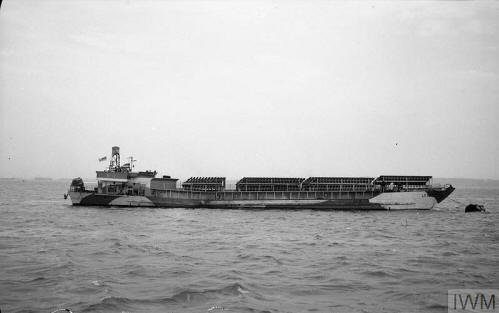
Background
These
personal recollections of Lt Commander Carr, Group Commander
of a flotilla of US Landing Craft Tank
(Rocket), US LCT (R)s, during operations off Normandy and Southern France in the summer of 1944. His
story starts with a brief aside concerning Pearl Harbour in 1941.
[Photo;
LCT (R) 440 was a sister ship of those mentioned in this account.
She is at anchor in the Solent, 3 June, 1944, On D-Day she supported the assault
of 69th Brigade, 50th Infantry Division, on King beach, Gold area. © IWM (B
5263)].
On December 7th, 1941, I was a Storekeeper 3rd Class on
the USS Antares, a stores issue ship returning from a mission south to Canton
Island. We passed through the submarine nets at the entrance to Pearl Harbour at
approximately 0625 and saw the conning tower of what we believed was a
Japanese midget submarine. Since the Antares was unarmed we alerted the
destroyer USS Ward, which was close by. The Ward depth charged the
submarine and struck the first blow in the war with Japan.
This action took place one and a half hours
before the Japanese planes attacked at
0755 that morning. We proceeded into the harbour but soon reversed to clear the harbour entrance
on realising the Japanese intention to sink us in the harbour mouth to
entrap the ships anchored inside.
In August 1942, we arrived in New Caledonia,
where I was ordered to report to Columbia University in New York City for
midshipman training. I completed the course in March 1943, commissioned an ensign and ordered to the Amphibious Base in Little Creek,
Virginia for Landing Craft Tank (LCT) training.
Organisation and Training
In September 1943, a ‘Special Support Group’
was established at the Little Creek
amphibious base near Norfolk, Virginia with a nucleus of three officers, Lieutenant Commander Louis E Hart, Lieutenant
D P G Cameron and myself, Lieutenant (jg) Larry W Carr, (jg = Junior Grade). We
were to train crews for what became ‘Gunfire Support Craft’ during
the initial assault phase of major amphibious beach landings. I
became Group Commander of the 14 LCT (R)s that became part of that group with Lt
D P G Cameron as my executive officer. In addition to these craft, we
also provided for 9 Landing Craft (Flak) and 5 Landing
Craft Gun (Large). All these craft would provide additional
in-shore support and cover for the troop carrying landing craft. Our LCT
(R)s were all British Mk3 LCT conversions,
which were twice
the size of the equivalent US Navy vessels.
As our Command
developed and expanded, in October 1943 we moved to Camp Bradford, Virginia.
We were soon responsible for144 officers and
1537 men recruited from all branches of the US Navy, including small boat crews,
midshipman schools, armed guard and boot camps. Training was provided in gunnery, fire-fighting,
recognition, gas warfare and communications. In addition, many officers and men practiced ship handling onboard LCTs. We were gaining
knowledge and skills but we
still required to organise crews
and appoint commanding officers; it was a slow process.
During late October 1943, we
were on the move again, this time to Fargo Building, Boston,
Massachusetts. As our duties and responsibilities intensified,
both officers and men attended Price’s Neck, an
anti-aircraft training centre on Rhode Island, for training
on
20mm and 40mm guns. Recognition of German aircraft followed, while
we waited to receive sailing orders for overseas
duties. When these came, the men were organised into groups
of twenty five and frequent musters were held to perfect the
training we had received. Essential equipment
arrived, including rifles, packs and foul weather gear and by November 20th,
1943, preparations were completed. We sailed for New York and on November 22nd,
departed the city aboard the Queen
Elizabeth bound for Scotland.
We arrived at Roseneath on the 28th,
known to us as US Navy European ‘Base
II’. Our converted British LCTs would not arrive for several
weeks, so a temporary operations base was set up
to include maintenance and engineering units
with associated training programmes in the technical
aspects of the unfamiliar British equipment
we were about to receive. These included
gunnery, communications and engineering, particularly the Paxman-Ricardo diesel engine.
Crews were also given further training in seamanship and the use of small arms.
Group
Formation
The LCT (R) group was organised on December 15th, 1943, as part of the
‘Special Support Group’, with myself, Lt. (jg) L W Carr appointed as group
commander. Officers in charge of particular craft were
assigned and their crews appointed. They were to become Division 1 of the
LCT (R) Support Craft of Force "O" (Omaha) of the US Eleventh Amphibious Force.
The staff consisted of: Ensign (Assistant Group Commander) D
G Swallow; Ensign (Gunnery Officer) F
D Michael; Ensign (Radar Officer) R
W Bennison; Ensign (Engineering officer) W
E Howard and Ensign (Communications Officer) E.
Bernstein.
The original complement of an LCTR was
seventeen men and two officers, with
fourteen craft assigned to the group. Commanding officers and assistant officers
were appointed as follows;
LCTR 366 Lieutenant
(jg) J C Ogren
& Ensign C M Podrygalski; LCTR 368 Lieutenant
(jg) G A Karlsen
& Ensign F A
Smith; LCTR 423 Lieutenant
(jg) W S Caldwell
& Ensign T J
Hurley; LCTR 425; Ensign R
W Ellicker & Ensign E
J Michalik; LCTR 439 Lieutenant
(jg) E H Mahlin
& Ensign G F
Fortune; LCTR 447 Lieutenant
(jg) W L Kessler
& Ensign A G
Rud; LCTR 448 Ensign B
Y Hess & Ensign B
P McDonald; _small2.jpg) LCTR 464
Ensign H
H Boltin & Ensign A
J Onofrio; LCTR 450 Ensign P
R Smith & Ensign T
A Cassidy; LCTR 452 Lieutenant
(jg) W B McCorn & Ensign R
L Payne; LCTR 473 Ensign G
M Taylor & Ensign P
H Prible; LCTR 481 Ensign A P
Dowling & Ensign A
G Hunter; LCTR 482 Lieutenant
(jg) H M Leete
& Ensign C A
Pink and LCTR 483 Ensign R
H Tucker & Ensign
E J Mack. LCTR 464
Ensign H
H Boltin & Ensign A
J Onofrio; LCTR 450 Ensign P
R Smith & Ensign T
A Cassidy; LCTR 452 Lieutenant
(jg) W B McCorn & Ensign R
L Payne; LCTR 473 Ensign G
M Taylor & Ensign P
H Prible; LCTR 481 Ensign A P
Dowling & Ensign A
G Hunter; LCTR 482 Lieutenant
(jg) H M Leete
& Ensign C A
Pink and LCTR 483 Ensign R
H Tucker & Ensign
E J Mack.
[Photo courtesy of Becky Kornegay, whose father, Quaver Stone
Stroud, served on US LCT (R) 439. The photo shows 439
proceeding in convoy for Normandy (6th June 44) or the South of France (15th
August 44) with her rows of rocket launchers clearly visible].
In Portsmouth on December 20th, 1943, Mk3 LCT
(R) 368
was the
first craft assigned to our group. It was in poor condition having seen
extensive service in the Mediterranean theatre as an LST
before conversion to an LCTR. LCT (R) 366 followed a short time later under similar circumstances
and by January, after
much cleaning and repairing, the 366 and 368
commenced training with the
British as part of the US Navy LCT (R) Group. Both attended an Assault Gunnery School
at HMS Turtle near Poole
in Dorset, England for live firing practice and the theory of LCT (R)s. Other
officers in charge, assistant officers and key ratings, while
awaiting the arrival of their own craft, completed similar training aboard the
366 and 368. Officers and selected ratings attended HMS Northney for radar training on British 970 and QH sets,
while other officers trained on the Brown Gyro compass
or continued training ashore at Base II.
The slow rate of delivery of the craft
was frustrating. I made numerous trips to see the Officer in Charge of Major Landing Craft at Troon,
in Ayrshire and in Glasgow in an effort to expedite delivery.
By the end of December 1943, the ‘Special Support Group’ became
known as ‘Gunfire Support Group, 11th Amphibious Force’ under the
overall command of Captain L S
Sabin, USN, with me as executive officer or
second in command. On February 6th, 1944,
additional officers and men arrived from the United States,
bringing the complement to over 2000
officers and men manning LCT (R), LCG (Landing Craft Gun) LCF (Landing Craft Flak)
and LCP (L) (Landing Craft Personnel (Large)), which would be deployed as
smoke-layers during the assault phase.
The entire group was, effectively an experiment in a new type of naval
warfare. The need for close inshore fire support for landing operations had been
identified in past amphibious invasions, including the
disastrous Dieppe Raid of August 1942. Heavy
naval gunfire from cruisers, destroyers and battleships,
while effective at direct and indirect targets often
miles inland, could not provide the close quarter support once the infantry had landed.
Converted landing craft with
their shallow draught were able to provide support close into
the landing beaches to fire on enemy positions. This
close quarter support for landing troops was vitally important
and the LCGs were aptly described by the BBC as 'mini battleships'.
Each type of craft performed a specific function. LCT
(R)s were designed to lay down an intensive barrage
of 1000 + explosive rockets just
prior to the initial assault waves landing, Flak craft were designed to cover
the flanks and to give air protection, as well as giving fire support against
machine gun nests on the beach, while Gunboats would fire on specific targets on
the beaches prior to H-Hour. After H-Hour they gave
close fire support against pill-boxes and other troublesome
gun emplacements.
A later addition to the group was the US Navy Mk5 LCT(A)’s or Landing Craft Tank (Armoured).
Tony Chapman of the LST and Landing craft Association adds;
The Mk5 LCT were American built tank landing
craft. They began arriving in England during 1942 and later many were carried in whole or
part by USLSTs and dropped off in England to be assembled or crewed. Prior to D-Day, close
to 160 had served with the Royal Navy under Lend-Lease and were dispersed amongst numerous LCT
flotillas. To separate them from their American sister Mk5 LCT, the British craft
had a 2 added in front of their original US Navy pennant number, thus, British
Mk5 LCTs carried pennant numbers in the 2000 series.
At various times 48 LCTs
were converted for specialist
duties and re-designated LCT (A)
(Armoured), LCT (HE) (High Explosive) and LCT (CB) (Concrete Buster).
The LCT (A)s
were fitted with a firing platform to the fore of the tank deck,
allowing the
tanks carried in the first assault waves to fire over the
LCT
(A)'s bows as they approach
the landing beach. In addition to the firing platform or ramp,
the LCT (A)s carried increased armour plate to the bows, bridge and wheelhouse
sections. Having landed, the tanks continued to give close fire support on the
beach.
Prior to D-Day, some 26
LCT
(A) conversions were lent back to the US Navy under ‘Reverse
Lend-Lease’.
It was these craft that became part of the Gunfire
Support Group 11th Amphibious Force. On the morning of D-Day,
distributed
across Omaha and Utah beaches, the
landing craft assigned to Omaha
delivered the
tanks of the 743rd Tank Battalion, while the craft assigned to Utah delivered the men of the 70th Tank Battalion. All the tanks carried
in by the two groups having the capacity to fire afloat.
The LCT(A) (HE) assigned to the groups were as follows: Utah beach Tare
Green sector - 2310, 2402, 2454, 2478; Uncle Red sector:- 2488, 2282,
2301, 2309. Omaha beach: Dog Green sector:- 2227,
2273; Dog White
sector:- 2050, 2276; Dog Red sector:- 2124, 2229; Easy Green sector:- 2075,
2307; Easy Red sector:-
2049, 2287, 2425, 2339 and Fox Green sector:- 2008, 2037, 2228, 2043.
Craft shown in blue are listed as War Losses in the assault area.
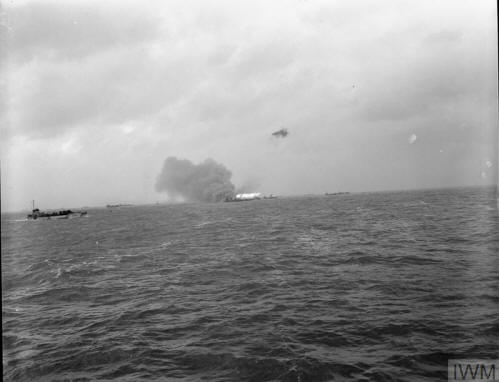 Each
LCT (R)
was designed to deliver hundreds of 5 inch diameter explosive
rockets on to the landing beaches just before the first assault troops were due
to land. The rockets had the
capacity to saturate an area
around 700 yards wide by 300 yards deep
to destroy enemy beach defences
including mines. Careful handling
and preparation, accurate navigation and precise
timing were vital to avoid hitting the assault troops on their final
approach to the landing beaches. Each
LCT (R)
was designed to deliver hundreds of 5 inch diameter explosive
rockets on to the landing beaches just before the first assault troops were due
to land. The rockets had the
capacity to saturate an area
around 700 yards wide by 300 yards deep
to destroy enemy beach defences
including mines. Careful handling
and preparation, accurate navigation and precise
timing were vital to avoid hitting the assault troops on their final
approach to the landing beaches.
[Photo;
An LCT (R) - Landing Craft Tank (Rocket) - in
action off Normandy, 6 June 1944. © IWM (A 23937)].
The two craft that fired during
the ‘Duck II’ demonstration
exercises created a great impression,
although one released her rockets far too early. Nonetheless, they proved to
the American observers that the rocket was a weapon which could pulverise a sector
of beach in the final few seconds before troops went ashore.
The proximity of
our own troops approaching the beaches elevated the timing of a rocket barrage
to the highest importance. Experience proved that rockets could
be safely fired when the leading assault wave was some 700 yards from the beach
or the point of impact of the rocket pattern. There were differences between the
British and American use of the LCT (R)s off Normandy. The British fired at H-Hour minus 10 minutes
while the American LCTRs
fired at H-Hour minus 2 minutes at targets slightly inland.
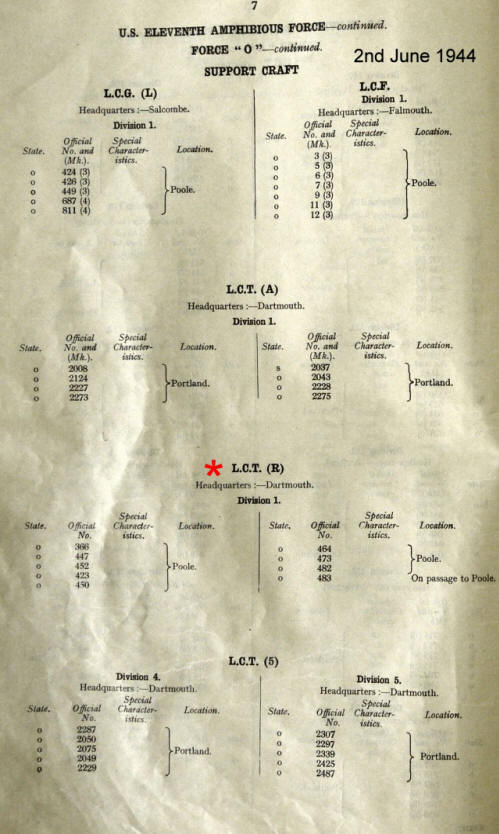 LCT
(R)
Specifications LCT
(R)
Specifications
The LCT (R)s were converted British Mk3 LCTs with a maximum length of 192 feet
and 31 feet across the beam. The standard power unit comprised two Paxman
Ricardo diesel engines giving a maximum speed of 9
knots, with both screws turning to starboard (right). An extra deck was
constructed over the tank space, on which either 972 or 1044 5"
rocket projectiles launchers were welded. The original design anticipated re-conversion of the craft,
so the crew's quarters, officers' quarters and magazines were separated
by canvas bulkheads. In order to make the US craft more comfortable and secure, the canvas was
replaced by steel or wood by their own crews. Home comforts included bunks and
hot water heaters.
[Left; Image from the Admiralty's Green List confirming
disposition of the LCT (R)s of Force O
(Omaha) on Jun 2nd, 1944].
The craft were equipped with 970 Radar, a
British set which swept 360 degrees in azimuth once a
second. Its maximum range was 25 miles
with three and a
half and seven mile range scales. Whilst the primary use
of the Radar was to accurately
determine where to fire the rockets, it proved to be a valuable
navigation aid. Each craft was also equipped with QH, a navigational aid and a
Brown gyro compass.
The 5" rockets were fired electronically by a series of switches in the
wheelhouse. Each switch would fire either 39 or 42 rockets per salvo, depending
on the total number mounted. One group of 36 rockets was wired
separately to provide twelve
salvos of three rockets each for the purpose of ranging.
All the projector tubes were mounted at a 45 degree angle to the waterline and all
pointed forward. The target area was covered by pointing the craft’s head at the
target, determining the range by radar and/or ranging salvos. The firing of salvos,
with a pre-determined short time interval between them, gained the desired depth of
pattern. The width of the pattern was 700 yards and could not be adjusted. The
depth of a complete broadside of 24 salvos could be achieved within the range of 300 to 1000 yards, or even more, if required.
A round consisted of three partitions, the fuse, projectile and propelling
unit. A complete assembled high explosive round was three feet in length and
weighed 59 pounds, 7 pounds of which was poured high explosive (TNT and Emitol).
The range of a high explosive round was 3580 yards. Incendiary rockets with a
range of 3900 yards were provided for ranging. Smoke rockets were also
available.
The LCT (R) had
several deficiencies. Extreme accuracy in navigation and a very steady course
was essential during a firing run. Rudders were very small and the rocket racks
increased the free board making the craft more
difficult to manoeuvre in the wind. ‘Aiming the ship’
 was the only way to line up the rockets with the intended
target and more
manoeuvrability would have been desirable. The LCT (R)s, nevertheless, proved to be an
effective weapon. was the only way to line up the rockets with the intended
target and more
manoeuvrability would have been desirable. The LCT (R)s, nevertheless, proved to be an
effective weapon.
The
Convoy
On March 20th, 1944, at Base II, two more rocket ships, Mk3 LCT
(R)s
447 and 448 were assigned to the US Navy. In brief ceremonies, the British flag
came down to be replaced by the American Ensign. On April 2nd, 1944, LCT
(R)
425 joined the group and the following day the craft formed a convoy south to their
permanent base at Dartmouth, England. I was in command of the convoy, which
consisted of three LCT (R)s, two LCFs and three LCGs. The route took us from Roseneath
by Stranraer, Douglas on the Isle of Man, then down the Irish Sea
to Appledore in Devon. Once around Land’s End,
we headed east
to Falmouth and Dartmouth. The 500 mile trip took five days and
was punctuated with many difficulties, including engine trouble, chronic sea-sickness and radio and radar problems.
[Right; Image from the Admiralty's Green List confirming
disposition of the LCT (R)s
of Force U (Utah) on Jun 2nd, 1944].
Maintenance was the most difficult problem to hand.
Without major overhauls there would be no
lasting improvement in the position. The craft were British LCTs
fitted with British equipment and parts, which were
difficult to obtain under the
elaborate and bureaucratic system of
the Reverse Lend-Lease scheme. The maintenance staff worked day and night when material became available,
although technical equipment such as radios and
Radar, continued to be problematical.
Staff offices were located in the Royal Naval College at Dartmouth around
April 3rd, 1944. My LCT (R) group,
at that time, comprised five craft with the
remainder still to be delivered. Fortunately, their crews were
already at Base II, in Scotland. After
repairs, 425,
447 and 448 sailed to Poole for the Assault
Gunnery School course.
Final
Preparations for D-Day
On April 15th, 1944, the LCT
(R) office was moved from Dartmouth Naval
College to Hunter’s Lodge on the River Dart. Moorings for our craft were assigned close by.
During April, the 366 and 368 took part in
the ill-fated ‘Exercise
Tiger’. Unfortunately they were not allowed to fire on the beaches, because
isolated units of the first wave landed an hour before H-Hour due to a
communications failure. Later that month, 366, 368,
425, 447 and 448 took part in exercise ‘ Fabius 1.’ The first
wave consisted of LCT (A)s and LCTs carrying DD tanks (Sherman Duplex Drive tanks,
swimming tanks).
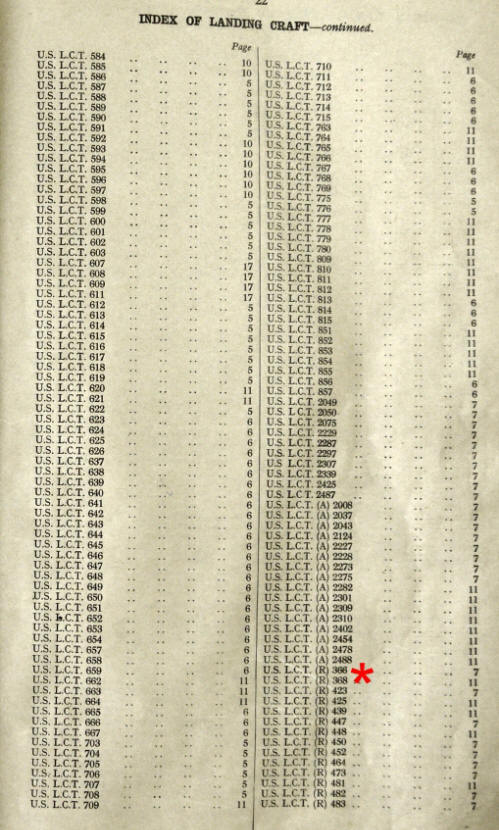 The original plan was
that the LCT (R)s were to open fire
when this wave was 300 yards from the shore but this was later deemed to be too
close for safety. Some difficulty was experienced in navigating through the
transport area to the correct firing position. LCT (R) 425 became lost in the
transport area and did not open fire at all and 447 failed to reach the
transport area. However, the three remaining craft successfully fired their
volleys and demonstrated once again the effectiveness of the rocket fire, which
completely obliterated their theoretical targets. The original plan was
that the LCT (R)s were to open fire
when this wave was 300 yards from the shore but this was later deemed to be too
close for safety. Some difficulty was experienced in navigating through the
transport area to the correct firing position. LCT (R) 425 became lost in the
transport area and did not open fire at all and 447 failed to reach the
transport area. However, the three remaining craft successfully fired their
volleys and demonstrated once again the effectiveness of the rocket fire, which
completely obliterated their theoretical targets.
On May 6th,1944, LCT
(R)s
423, 450, 452 and 464 arrived in Dartmouth. These craft were much newer and
required much less maintenance, although radar and radios were
still a problem.
[In this index page from
the Admiralty's "Green List" the prefix US is used for the LCT (R)s
whereas on the disposition pages above no prefix is used. This is most likely
because the "US Eleventh Amphibious Force" heading renders the US designation
against individual craft superfluous].
They
immediately embarked upon a number of exercises to bring the crew and craft up
to operational standard with a series of firing exercises on the Slapton Sands assault area.
The British gunnery school at Poole was, by then, closed but these training
exercises, which we undertook on our own initiative,
proved beneficial. Emphasis was placed on timing and accurate ranging using test
salvos and radar.
On May 17th, 1944, LCT
(R)s 439, 473 and 482 arrived in Dartmouth. We
were still missing 481 and 483. Training continued throughout May and every craft
was given a complete operational check. There was a noticeable increase in
activity and intuitively we knew that D-Day was at
hand. Our skills were fine tuned with daily firing runs into mock enemy beaches.
Two sets of rockets were loaded onto each craft - one for the racks and the other for the magazine. Other materials were taken
aboard and detailed logistics and intelligence plans were received. All sorts of
publications about our mission were distributed.
It was now
glaringly obvious that the invasion date was near. Our craft were assigned to
two forces, 366, 423, 483, 447, 450, 452, 464, 473 and 482 were assigned to ‘Force
Oboe’ under Rear Admiral Hall and 368, 425, 439, 448 and 481 were assigned to
‘Force Uncle’ under Rear Admiral Moon.
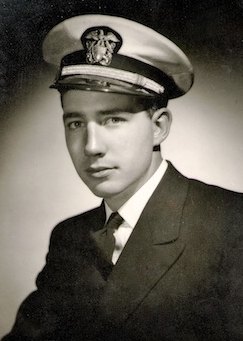 Late in May, ‘Third’ officers were assigned to each of the craft. Those
officers who had served with gunfire support craft in other capacities were sent
to radar school and joined the LCTRs primarily as radar officers. However, most
of their duties were on deck but they all proved to be a valuable addition to
the efficiency of the group. The allocation of the ‘Third’ officers to their
craft was as follows; Ensign F D Michael to 439, Ensign R E Worthen to 366, Lt
(jg) R
W Bennison
to 368, Ensign R L Palmer to 423, Ensign R M Costello to 425, Ensign G D Soule
to 447, Ensign G L Hershman to 448, Ensign D G Swallow to 450, Ensign J C Cavness
to 452, Ensign C H Easley to 464, Ensign G P Sherman to 473, Ensign P T Wilson
to 481, Ensign J J Lassiter to 482 and Ensign S S Rough to 483. Ensign Michael and Lt
(jg) Bennison went aboard the 439 and 368 for temporary
duty. Late in May, ‘Third’ officers were assigned to each of the craft. Those
officers who had served with gunfire support craft in other capacities were sent
to radar school and joined the LCTRs primarily as radar officers. However, most
of their duties were on deck but they all proved to be a valuable addition to
the efficiency of the group. The allocation of the ‘Third’ officers to their
craft was as follows; Ensign F D Michael to 439, Ensign R E Worthen to 366, Lt
(jg) R
W Bennison
to 368, Ensign R L Palmer to 423, Ensign R M Costello to 425, Ensign G D Soule
to 447, Ensign G L Hershman to 448, Ensign D G Swallow to 450, Ensign J C Cavness
to 452, Ensign C H Easley to 464, Ensign G P Sherman to 473, Ensign P T Wilson
to 481, Ensign J J Lassiter to 482 and Ensign S S Rough to 483. Ensign Michael and Lt
(jg) Bennison went aboard the 439 and 368 for temporary
duty.
[Photo right; Ensign J C Cavness of US LCT R 452].
During the last week of May, all craft in Force 'Oboe' were ordered to Poole and
the craft of Force 'Uncle' to Salcombe to prepare for the invasion. LCT (R)s 481 and
483 arrived loaded and ready to go at their respective ports of embarkation on
June 1st. The crews of both craft had passed through gunnery school
on other craft but they did not fire a rocket from their own craft until the
invasion.
The Invasion -D-Day
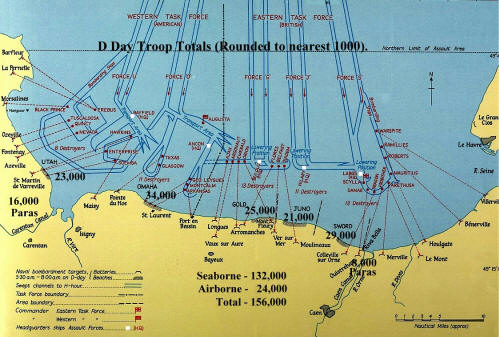
On June 3rd, all LCT
(R)
personnel were briefed on their role in the coming invasion.
Maps of our landing beaches were issued, landmarks and targets
identified and intelligence reports
issued, all set within the wider context of the task ahead. It was especially important that
the LCT (R) officers familiarised themselves with the terrain, landscape and landmarks of the beach
to accurately pin point their target. As an aid, a PPI
screen prediction was added to the radar devices,
which they could compare with the live PPI screen display as they approached
their landing beach. When the two images matched
they were ‘on target’.
Frequent briefings and
further study of the meticulous and
detailed plans followed. At 0300 hours on the morning of June 4th,
1944, after a final briefing to my men, the craft of Force
'Oboe' sailed in
convoy for France. The craft of Force 'Uncle' had sailed at 1600 hours on the
afternoon of June 3rd, however, the weather had
deteriorated and all ships were ordered back to their starting points. The LCT
(R)s of ‘Oboe’ had LCMs in tow carrying demolition units and these greatly
hampered ship handling. The ‘Uncle’ LCT (R)s had LCP (L)s in tow. The craft
for the ‘Oboe’ convoy returned to Poole
and the craft of the ‘Uncle’ convoy put
into Portland.
The weather had improved a
little when the convoys
got underway for the 2nd time on June 5th and headed for
Normandy. Manoeuvering the unwieldy gunfire support craft
was very difficult in the rough
waters of the English Channel. At approximately 0500 hours on the morning of June 6th,
1944, the convoys arrived at their respective transport areas, where the tows
were detached. 425 had fouled her screws and was
assisted down the mine
swept lanes in convoy towards the line of departure. This was
the starting point for our final approach to our designated beaches and at approximately 10,000 yards offshore the LCT
(R)s formed up line abreast and began their run for the beach. H-Hour was set
at 0630 hours.
.jpg) All
craft discharged their rockets. The first craft to
engage the enemy was 366 at H-Hour-7 minutes,
while LCT (R)s 450 and 447 fired when the LCT (A)s were 500 yards from the
beach at H-Hour+2 minutes. The other craft
discharged their rockets at intervals between those times.
Reports later submitted
by
the officers in charge described the action; All
craft discharged their rockets. The first craft to
engage the enemy was 366 at H-Hour-7 minutes,
while LCT (R)s 450 and 447 fired when the LCT (A)s were 500 yards from the
beach at H-Hour+2 minutes. The other craft
discharged their rockets at intervals between those times.
Reports later submitted
by
the officers in charge described the action;
-
Time of firing H-7 minutes to H+2 minutes.
Estimated position of the
first troop carrying assault craft
varied between 2000 yards and 200 yards from
the beach
-
Officers believe they fired on target in all instances.
-
Time taken to
reload varied between between 9
and 19 hours. The difference was
accounted for by random events, including the loss of anchors, rockets
stuck in boxes and large numbers of misfires requiring the
removal of the projectiles.
-
The 970 Radar and the PPI Predictions were
deemed successful by all craft.
All craft fired 'ranging salvos'
but poor visibility prevented
accurate
calculation of their points of impact. With the exception of LCT R) 366, ranging
salvos were used only to ‘check’ the accuracy of the radar.
-
[Photo courtesy of Becky Kornegay].
-
The extremely
shallow water in the vicinity of several beaches added to the
difficulty in ranging salvos, because the
rockets could easily have exploded
short of the beach in the water,
giving the impression they had reached the beach. All craft,
with the exception of the 366, therefore, fired by radar at the pre-determined range.
Firing positions were
calculated
with reference to landmarks and fixes, obtained in some instances by QH and in
others by 970.
-
There were no casualties to either the craft or the personnel
and no craft
fired a second load of rockets. On June 9th, ‘Oboe’ LCT
(R)s returned to
Poole and on June 12th, ‘Uncle’ LCT (R)s returned to Portland. The US Navy
LCT (R) Group had fired 12,605 rounds of high explosive ammunition and 326 rounds
of incendiary on to the beaches of Normandy. Their mission was considered
a success.
After a week in the 'return convoy' ports, the LTC
(R) group returned to
Dartmouth. There were no orders, so we took the opportunity to
carry out routine maintenance repairs.
The
Mediterranean
On June 29th, 1944,
orders came to prepare nine craft for operations in the Mediterranean area.
All nine craft were painted American Battleship Grey,
the engine tops were
overhauled, new American TCS radios were installed and radars
were checked and
repaired as required. Provisions were taken on board and the fire fighting equipment
greatly improved. Because US bases did not carry
spares for our British LCT (R)s, we stocked up with more spares than usual. Time was
tight but, with close co-operation and coordination between the base
and the craft, work progressed apace, including dry dock
repairs to damaged hulls. Ensigns C H Lockwood and B
T Geckler joined the group as ‘Third’ officers
on 439 and 368. The entire staff moved aboard and we were
ready to sail. The intense effort had taken just one week.
On July 7th, 1944, our group sailed to Plymouth to join
ten British manned LCT (R)s for the passage to the Mediterranean
and 4 days later the commanding officers were briefed
on the convoy. It comprised the combined British and US Navy LCT
(R)s, two
destroyers and five tugs. After the briefing, Admiral J L Hall addressed the US LCT
(R)
officers in charge. He expressed gratitude for a job well done off the Normandy
beaches, being aware of the many
difficulties and problems experienced. He requested the officers in charge to convey
his appreciation to the officers and men.
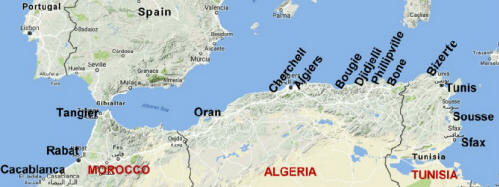 On July 12th,
the convoy set off for Gibraltar and the trip was
comparatively uneventful. There were submarine alerts but no signs of enemy aircraft. Gibraltar was
sighted on July 20th and new orders were received for the USLCT (R)s to
continue to Oran, where we arrived on July 21st
thus completing the longest non-stop trip ever attempted by such
craft. The British elements remained in Gibraltar. On July 12th,
the convoy set off for Gibraltar and the trip was
comparatively uneventful. There were submarine alerts but no signs of enemy aircraft. Gibraltar was
sighted on July 20th and new orders were received for the USLCT (R)s to
continue to Oran, where we arrived on July 21st
thus completing the longest non-stop trip ever attempted by such
craft. The British elements remained in Gibraltar.
[Map courtesy of Google Map Data 2017].
The craft functioned surprisingly well, although
two suffered air locks in their fuel supply
lines and were taken under tow until repairs could be
made. Of the 24 craft, only four required a tow at any time
and we completed the10 day trip at an average speed
of seven and a half knots, made possible by favourable
weather and sea conditions.
On July 23rd, we set off for Bizerte
without tugs or escorts. LCT (R)s
366 and 450 broke down one day out and
they returned to Oran under tow, while the
rest of the convoy continued for Bizerte with 473
taken under tow at some point, when
one of her two main engines broke down. There was a heavy sea on the night of July
25th, so the convoy resorted to tacking for twelve hours
to keep the craft more stable. All
twelve craft arrived in Bizerte Road at 2300 hours on July 28th,
1944 and entered Bizerte Harbour on July 29th, in need of
extensive repairs.
However, before major overhauls
could be carried out, the most serviceable craft sailed to Naples between the 1st and 5th
August with others following on in
small groups as they became operational. LCT (R)s 366 and 450 arrived in Bizerte on
August 3rd, by which time 366 needed two new engines and the 450’s
ballast tanks were leaking into her fuel tanks.
In Naples, the briefings for the new campaign began with little time for thorough
scrutiny of the plans. However, our previous experience
off Normandy made the process
easier to understand.
The craft had sailed without their complement
of rockets for damage control reasons but supplies, thought to have been in
Naples, fell short of our requirements.
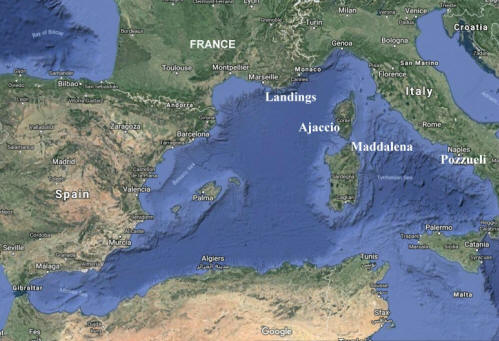 LCT
(R)s 366, 450, 481 and 423 sailed to the Pozzuoli staging area on August 9th
unloaded. The 366 had two new engines installed and the 450 had filled
her ballast tanks with fuel oil to make the trip. All craft arrived at the Pozzuoli staging area in operational condition. En
route to Ajaccio, 366, 423, 450 and 481 left the convoy for Maddalena to load. Fuses needed by other craft were flown to Ajaccio and all the
craft left Ajaccio loaded and in operational order. LCT
(R)s 366, 450, 481 and 423 sailed to the Pozzuoli staging area on August 9th
unloaded. The 366 had two new engines installed and the 450 had filled
her ballast tanks with fuel oil to make the trip. All craft arrived at the Pozzuoli staging area in operational condition. En
route to Ajaccio, 366, 423, 450 and 481 left the convoy for Maddalena to load. Fuses needed by other craft were flown to Ajaccio and all the
craft left Ajaccio loaded and in operational order.
[Map courtesy of Google. 2019].
Operation
Dragoon - The
Invasion
of Southern France
At 1930 hours on the evening of August 13th, 1944,
the first assault convoy got underway for France. The weather for the entire
trip was favourable and the movement plan was accomplished, although the convoy
speed of 4-5 knots was too slow for our flat bottomed craft to keep
good station.
LCT (R)s 366 and 425 were assigned to Blue Beach and on Green Beach 368, 423,
447, 452, 482 and 483 were assigned to the original assault in the Camel area. LCT
(R)s 439, 448, 450, 464, 473 and 481 were assigned to Red Beach for the Z hour
assault. They were joined by the reloaded LCTR 425 and a number of British
craft.
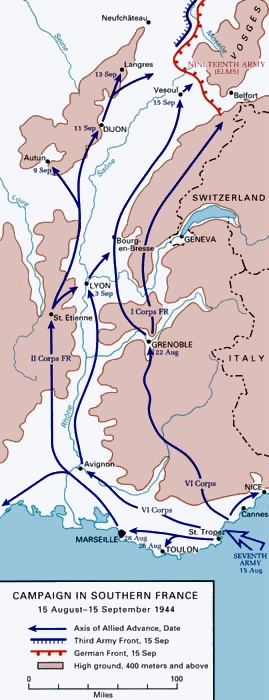 The craft on Blue Beach reported
no opposition. Lieutenant J C Cohen USNR, commanding 366, fired at H-5 minutes
to cover a ‘rather slow first wave’. Lieutenant (jg) R E Ellicker, commanding
425, fired at approximately the same time. Both craft believed themselves on
target although haze and dust on the beaches made a positive sighting impossible.
Superficial damage and fires were caused aboard both craft by the intense heat
of the propelling charge. The craft on Blue Beach reported
no opposition. Lieutenant J C Cohen USNR, commanding 366, fired at H-5 minutes
to cover a ‘rather slow first wave’. Lieutenant (jg) R E Ellicker, commanding
425, fired at approximately the same time. Both craft believed themselves on
target although haze and dust on the beaches made a positive sighting impossible.
Superficial damage and fires were caused aboard both craft by the intense heat
of the propelling charge.
The six craft on Green Beach fired approximately as scheduled. Reports
indicated that 447 of Lt W L Quest fired at H-9
minutes, 452 of Lt W B McCown fired at H-6 minutes, 423 of Lt (jg) W S
Caldwell fired at H-5 minutes, 483 of Lt (jg) R H Tucker fired at H-5 minutes
and finally Lt G A Karlsen, commanding the 368, fired at H-Hour. The 368
was on the flank but did not fire over the troops. Sporadic enemy gunfire was
observed but all fell short of the craft.
The radar on 447 stopped
working by H-1 hour and she was forced to rely on
ranging salvos, which were difficult to observe on a hazy beach. The 482 reported
strips of light metal resembling tinfoil
falling from the sky, which fogged the PPI
picture but the problem cleared up before firing. The remainder of the craft
recorded no problems. The beaches were again obscured by the pre-H-Hour
bombardment and the precise impact locations could not be
confirmed from
the firing range. Craft in the boat lanes experienced difficulty in standing
clear of the second wave.
The craft assigned to Red Beach formed up and proceeded to the line of
departure in order to carry out the Z Hour assault at 1400 hours. Once there,
they stood by for approximately one hour between 1345-1445, awaiting the
completion of an unsuccessful attempt to destroy obstacles on the beach by Apex
boats. During this time, they were subjected to sporadic gunfire, which came
extremely close. However, all the projectiles fell
short, suggesting that the shore
batteries were firing at their extreme range. Shrapnel fell on the
decks of all the craft involved and Seaman Richard Charles Syers, serving with
LCTR 439, was hit by a nearby
burst at about 1430 hours. He
was the only casualty in the group. Upon receipt of the order to proceed to
Green Beach, the LCT (R)s returned to the transport area and stood by.
At about 1430 hours on D+1, all LCT
(R)s
received orders from LCH 240 (Landing Craft Headquarters 240) for
onward routing and at about 1630, the craft sailed in a nine knot convoy, for Ajaccio.
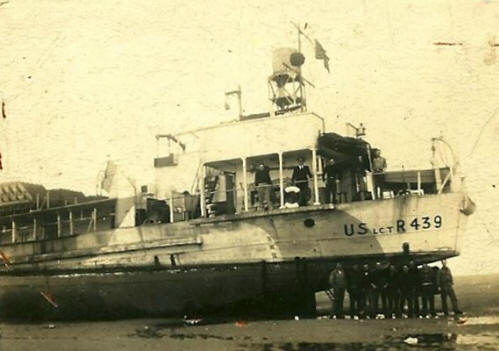 However, after 7 hours, they were all ordered to return to Red Beach, because an
escorting vessel had become detached during the night. By the time the craft set
off for a second time, both 448 and 452 had problems with one of their engines
and were taken under tow. All craft arrived safely in Ajaccio on August 19th. However, after 7 hours, they were all ordered to return to Red Beach, because an
escorting vessel had become detached during the night. By the time the craft set
off for a second time, both 448 and 452 had problems with one of their engines
and were taken under tow. All craft arrived safely in Ajaccio on August 19th.
[Photo of US LCT (R) 439,
courtesy of Becky Kornegay].
The LCTRs remained for a day and then sailed for Bizerte, arriving there on
September 1st. At Bizerte, repairs were
undertaken and all craft were repainted. They were not
returned to England as expected for
transfer back to the Royal Navy, instead they were transferred to the British base at Messina and all US Navy
personnel repatriated. On October 4th, 1944, all the LCT
(R)s were
returned to the Royal Navy.
Conclusion
Following the return of our craft back to the Royal Navy, my officers and men
returned to America by ship. I flew back to Washington for a new assignment,
where the
Bureau of Naval Personnel appointed me to
set up a training programme for crews
of the new LSM (R) rocket ships being built for the US Navy.
All of my
former officers and crews were ordered back to Little Creek for training.
I was later assigned as Flag Lieutenant to Admiral Lowrey in San Diego, who
was to command the amphibious forces for the invasion of Japan. The end of the
war in 1945 resulted in my being returned to inactive duty on September 14th
1945.
The use of British rocket craft proved of great value to
the US Navy. In no small measure, they made a significant contribution, furnishing support
for our troops landing both in Normandy and in Southern France.
The job of recruiting
and training personnel for our
British rocket ships and the development of the associated administrative
organisation was challenging, as inexperienced personnel worked in unfamiliar
craft within a limited time. It required
close co-operation between the groups and their
British counterparts. With the successful completion of its missions, the LCT
(R) group, the first of its type in the US Navy, considered its
task was well done.
Key points in the author's naval service
Pearl Harbour. 1941. He was on the first US Navy vessel that witnessed
a Japanese midget submarine in Pearl Harbour and later the attack on December 7th,
1941.
D-Day-Normandy. June 6th. 1944.
Group Commander of all US Navy Rocket Ships (LCTRs) to fire on to the
beaches just 300 yards ahead of the first assault wave.
D-Day Southern France. August 1944.
Still Group Commander of all LCTRs to fire ahead of the first assault wave.
LSMR Programme.
First US Naval Officer attached to a new programme to
train men in the use of a new generation of rocket ships built for the invasion of Japan.
Further Reading
On this
website there are around 50 accounts of
landing craft training and
operations and landing craft
training establishments.
There are around 300 books listed on
our 'Combined Operations Books' page. They, or any
other books you know about, can be purchased on-line from the
Advanced Book Exchange (ABE). Their search banner link, on our 'Books' page, checks the shelves of
thousands of book shops world-wide. Just type in, or copy and paste the
title of your choice, or use the 'keyword' box for book suggestions.
There's no obligation to buy, no registration and no passwords.
Correspondence
Mr. Slee,
US LCT (R) 483
My late uncle, Charles R. Murphy served aboard the US LCT (R) 483 at the
time of the Normandy Invasion, etc. Briefly his story is as follows.
He enlisted in the Navy on June 17, 1943, but he "misstated" his actual date
of birth as June 16, 1926 instead of the actual date of
June 16, 1927. After boot camp, he attended electricians
school and then assigned to the USS LCT (R)
%20483%20Crew_small.jpg) 483 just in time for D Day. In
other words, he was 16 years of age at the time the ship was off Omaha
Beach. He told me that an interesting aspect of his time on the ship was that
they had not fired their rockets before D Day itself and they had to move in
close to the beach to fire the rockets, then he saw the Army troops being
ferried toward the beach as they withdrew from the area. 483 just in time for D Day. In
other words, he was 16 years of age at the time the ship was off Omaha
Beach. He told me that an interesting aspect of his time on the ship was that
they had not fired their rockets before D Day itself and they had to move in
close to the beach to fire the rockets, then he saw the Army troops being
ferried toward the beach as they withdrew from the area.
[Photo;
Part of Crew, USLCT
(R) 483.
(L-R),
Top Row W. Snell, S 1/c, Bill
Cunningham, SY c, N. White, S 1/c, H Ricks, MoMM 2/c, B. Brennan, RM 3/c, R.
Jones, GM 2/c. Second Row
LTjg R.H. Tucker, D.C. Hurley, SM 3/c, Davy Turner S 1/c,
C. Orlando S 1/c, Jim Finn, QM 3/c, ENS E.V. Mack.
Third Row Paul Hannah, MoMM
3/c, R. Perkins, Cox., C. Murphy, F 1/c, Tom Derr, MoMM 3/c].
After the LCT's were turned back over to the British Navy, he was assigned
to the USS Clarion River [LSM (R) 409], rode it to the Pacific
theatre and was aboard this ship when the war ended. At the time, he was an
Electrician's Mate 3rd Class.
%20483%20II_small.jpg) After the war, he knocked around the San Diego area for a while, then joined
the Army just in time to be sent to Korea where his outfit, the 163rd
Artillery, was over-run by North Koreans. He was reassigned to Pusan in the
Quartermaster Corps and decided to stay in the Army. He served in Germany,
two tours in Vietnam (where he was awarded the Bronze Star), etc. and retired
as a Sergeant-Major. He died on May 17, 2017 in North Little Rock, AR. He
will be buried with full military honors on June 16, 2017 on what would have
been his 90th birthday. After the war, he knocked around the San Diego area for a while, then joined
the Army just in time to be sent to Korea where his outfit, the 163rd
Artillery, was over-run by North Koreans. He was reassigned to Pusan in the
Quartermaster Corps and decided to stay in the Army. He served in Germany,
two tours in Vietnam (where he was awarded the Bronze Star), etc. and retired
as a Sergeant-Major. He died on May 17, 2017 in North Little Rock, AR. He
will be buried with full military honors on June 16, 2017 on what would have
been his 90th birthday.
[Photo; taken from
US LCT (R) 483, possibly on D Day or some other major landing or training
exercise in view of the numbers of vessels in view].
As an aside, I have the flag of the US LCT (R) 483 that was flying on D Day.
As he related to me, sometime after D Day, due to the storms and the smoke,
etc. from the rockets, the flag had become tattered and was being replaced.
He asked the Captain for the flag and he sent it home to a sister, who kept if
for years, then returning it to my uncle, who gave it to me this past year. I
have it "framed" in my office in a flag case....indeed, it is stained and
tattered. He had an interesting life and never tired of telling stories from his time
in the Navy and the LCT (R) 483 in particular.
Acknowledgments
These personal recollections of Lt Commander Carr concentrate on
the use of US Landing Craft Tank (Rocket) off Omaha, Utah and Southern France. They were transcribed by Tony Chapman, Official Archivist/Historian of the LST
and Landing Craft Association (Royal Navy) and edited by Geoff Slee for publication on the Combined Operations website
including the addition of maps, Imperial War Museum photos and extracts from the
Admiralty's 'Green List' of landing craft dispositions.
US LCTR Flotilla - Diary Entries of Seaman Ist Class, Jack
Nicholas
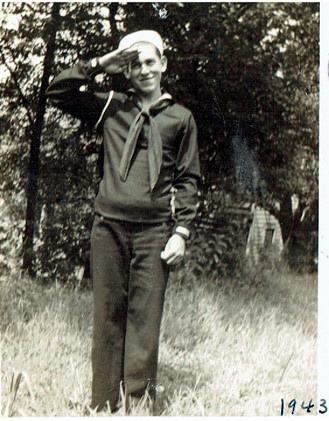 Jack
Nicholas S 2/C,
A.T.B. Camp Bradford N.O.B, Unit
King Tent 67,
Norfolk, VA Jack
Nicholas S 2/C,
A.T.B. Camp Bradford N.O.B, Unit
King Tent 67,
Norfolk, VA
Special Support Group,
Nov
22, 1943
Left
Boston 1630 - 1637
men.
Nov
23, 1943. Took Ferry across Hudson River to N.Y. where we went aboard the Queen
Elizabeth. Left over seas at 1530. We seen the statue of Liberty as we left.
Nov
28. We landed in Scotland at 0831, 25 miles west of Glasgow and now waiting to
go ashore
Nov
30. We will go ashore to day for the first time at 0900.
Dec
1. We are ashore now and living in huts. There is sure a lot of pretty places
around here.
Dec
15. We formed our rocket crew and are living in one area.
Dec
25. Had turkey for chow today, and it was pretty good too. Didn’t seem like
Christmas though.
April 9, 1944. We got our rocket ship today, it is about time.
April 13. We took over from the British, it’s now our ship.
April 21. We
left for Dartmouth today.
April 21. We
landed in Lock Ryan at night.
April 22. Isle
of Man. Went
ashore and had a good time.
April 23. Holyhead, North Wales.
April 24. Milford Haven. We
missed convoy so we will have to wait till tomorrow.
April 25. We
went out but we came back into port again.
April 26.
Still in Milford Haven.
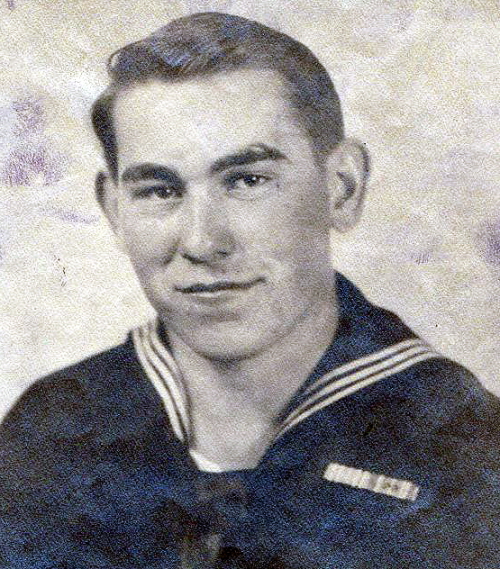 April 29.
Arrived in Dartmouth, England. It is sure pretty good weather here, but liberty
is sure lousy. April 29.
Arrived in Dartmouth, England. It is sure pretty good weather here, but liberty
is sure lousy.
May
1. It
was sure a swell day today. We were supposed to go to Plymouth but didn’t.
May
2. We
went to Plymouth today. We will stay there all tomorrow.
May
3.
Worked all day, air alert at 1500.
May
4. Worked all day. Had liberty but didn’t take it. Wrote letters and listened to
music in radio shack.
May
5.
Lippy, Titlow, Mahon took dingy and came back drunk as hell. Old man raised
plenty of hell.
May
6. Left Plymouth 0800 for Dartmouth at 5 pm.
May
7. Went
to Church in Dartmouth.
May
8. Went
on maneuvers but didn’t fire.
May
9th.
Fired rockets for first time. Quite a sight.
May
10.
Fired again, not much else.
May
11. Got
stuck in mud going to sea, turned around and spent eve in Dartmouth.
May
12.
Washed clothes and laid around, didn’t go out.
May
13.
Didn’t go out again.
May
14. Went
out this morning. Air alert 3 am.
May
15. Alert
at 1 pm, also early in morning went out on firing range also in aft.
May
16. In
port-also my birthday.
May
21.
Refueling and taking on fresh water.
May
23.
Started early this morning for Plymouth. Got there in evening and loaded 522
rockets.
May
24.
Started loading rockets early morning and worked all day and part of night. Took
on 2088 rockets and fuses. Was really tired.
May
25.
Finished all loading and slept in aft.
May
26. Early reveille left for Dartmouth. Rough sea, most of the boys got sick but
I didn’t. Saw a mine to close for comfort. Got back early evening and wrote
letters.
May
27.
Didn’t go out today.
May
29. Was
sick all day today with the cramps. We left for Poole early in the morning. Got
there at 2200.
May
30.
Didn’t go out today. Went swimming this afternoon. Sure felt good. I met Reed
today. I sure was glad to see him. He is in LCF3.
May
31.
Still in Poole, didn’t go out today. Went swimming at night.
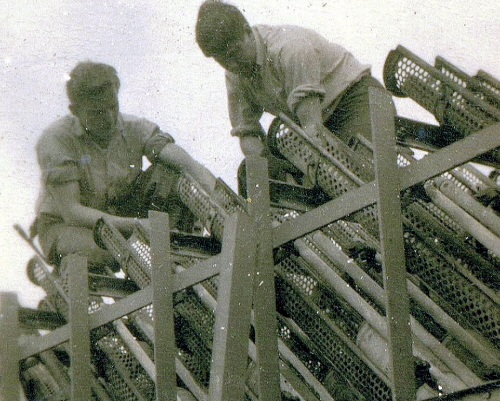 June
1.
Changed rockets around today. We still didn’t go out. Still waiting for the big
push and sick of this shit barge. June
1.
Changed rockets around today. We still didn’t go out. Still waiting for the big
push and sick of this shit barge.
June
2. Went out to calibrate radar sets and anchored, anchor chain broke and we
were adrift, what an experience. Hurley took all of our money.
June
3.
Weighed anchor for invasion but gale forced us to postpone operations for 24
hours.
[Photo; Rocket launching racks].
June
4.
Weighed anchor at 0200 for France. Passed convoy of 30 liberties.
June
5. In
middle of channel on way to France. The craft behind us broke loose and is under his
own power.
June
6, 1944 Tuesday.
D-Day. Wagons opened up at 6:00. H-hour at 6:30. Went into beach under fire and
tanks fired over heads. We fired 1044 rockets at our objective. It was
demolished. I sure would have hated to be on that beach.
June
7.
Jerry over last night and at daybreak, troops are moving inland over the hill.
June
8. We
started back for Jolly ole England and got in Poole last night and anchored out
of the harbor.
June
9. Came
into port this morning and took on fuel and then we anchored. Heard news
tonight, sounds pretty good.
June
10. Stayed in port today although we were supposed to go out and fix compass.
Went ashore at Poole to get supplies. Had chicken today, listened to radio tonight.
June
11.
Didn’t do a damned thing, I heard Jack Benny on radio.
June
12. We
had to kill Tuffy today, he took a fit, we put him in a sack and threw him
over, and then we shot him. I also got two letters today too.
June
13.
Nothing happened today. Gee we sure miss Tuffy.
June
14.
Nothing happened today. It rained all morning. Fixed radio in quarters this
afternoon.
June
15. We
left for Dartmouth at 14:30. We are still under way at 24:00.
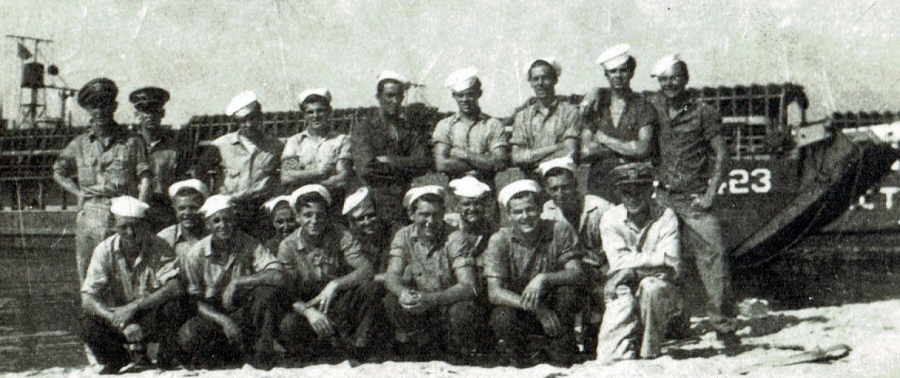 June
16. We
got here in Dartmouth at 02:30. We anchored out until daylight and then we came
in, went ashore and got a haircut, shower and went to the movies. June
16. We
got here in Dartmouth at 02:30. We anchored out until daylight and then we came
in, went ashore and got a haircut, shower and went to the movies.
June
17.
Didn’t go out. Went swimming this afternoon. Water was pretty cold. Had guard
from 2000 till 2400 tonight. Wrote a letter to June Brown.
[Photo; US Crew of LCT (R)].
June
18.
Didn’t go out today, just laid around in the sun. Had chicken for dinner today.
Was pretty good. Sure is a lot of scuttle but going around.
June
19.
Didn’t go out today, went swimming this afternoon and got sunburned. It hurts a
little now but I think it will be all right tomorrow. I got some mail today, the
first for some time.
June
20. Went out on liberty today to Torquay. It sure is a pretty
nice place, came back drunk.
June
21.
Didn’t go out today – started to paint our quarters blue. It sure is a big job,
but it looks much better. Had a little hangover from yesterday.
June
22.
Didn’t go out today, washed some clothes. We walked two
girls home. We started to defuse the rockets today.
June
23.
Didn’t go out – we were defusing rockets all day today. Also got a new dingy and
took some pictures too. I wrote some letters tonight.
June
24. Went on liberty at 1300. Didn’t get back until next morning. Had
a very good time on liberty and went to Newton.
June
25. Got in at 0800. Didn’t do anything but sleep. Wrote a letter
to Mom and Bill.
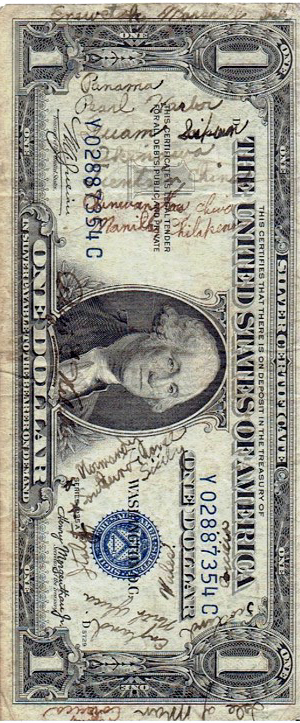 June
26.
Didn’t go out, took rockets below deck out of the racks. Took fuses away and
then started to scrape. Went on liberty. June
26.
Didn’t go out, took rockets below deck out of the racks. Took fuses away and
then started to scrape. Went on liberty.
June
27.
Didn’t go out, rained all day long, scraped paint all day.
June
28.
Didn’t go out, scraped paint till 4:30 and then went on liberty. Saw picture
'Uninvited'. It was very good.
July
3. We
are still at the docks getting repaired. I sure would like to know where we are
going. The ship is painted all blue now.
July
5-6.
Fixing up ship.
July
7. We
left for Plymouth at 1300. Got there at 0800. I don’t know how long we will be
here.
July
8. Crew
went out to check compasses me and two other men and an officer went after
supplies. We were gone from 0800 till 2400. Lost my dog tags.
July
9.
Didn’t go out, had the dishes to do today. It was raining all day.
July
10. We
are still here in Plymouth, no liberty. We are waiting to pull out for
somewhere. God only knows where. All we do is lay around and play cards and
read. We were supposed to leave today but it was cancelled for 24 hours. So we
will leave tomorrow.
July
12. Well
we left at 0800 this morning for Gibraltar, it will take us about 12 to 14 days.
The trip will be 1400 miles. There are 14 American rockets craft and 10 limie rocket
craft.
It was nice and calm today.
July
13. 2nd day of trip, was slightly rough today. We are standing 3 on and 6 off.
Took a picture of a sea hawk today. It was sitting right on our rails. About
three guys were sick today. I never thought we
would sail the Atlantic ocean in an LCT. We are about 150 miles off the coast of
France now.
July
18.
Smooth sailing, Was out in the sun all day, can stand watch at
night in skivy shirt. Course 136. Expect to be in Gibraltar in two days.
July
19.
Still smooth sailing, they changed the orders today. We will go to Oran instead
of Gibraltar. I don’t think we have enough fuel to get there, but my sunburn
sure hurts.
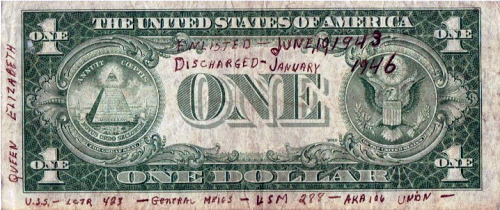 July
20. We
ran out of fuel and are being towed by a tug. We went through the Strait of Gibraltar
this afternoon at 1200. Gibraltar was on our left and Spanish Morocco, North
Africa on our right, the water here in the Mediterranean is dark green, where it is sort
of dark blue in the Atlantic. We are still sailing, expect to be there late
tomorrow. July
20. We
ran out of fuel and are being towed by a tug. We went through the Strait of Gibraltar
this afternoon at 1200. Gibraltar was on our left and Spanish Morocco, North
Africa on our right, the water here in the Mediterranean is dark green, where it is sort
of dark blue in the Atlantic. We are still sailing, expect to be there late
tomorrow.
July
21. We finally got to Oran, we were towed to Gibraltar and then refueled and
we came under our own power to Oran. I had dished today also. It sure is nice
here. Went swimming as soon as we anchored but they chased us out later.
July
22.
Still in Oran, went ashore today at 1300. Came back at 2200. It sure is a crummy
place, all natives or Frenchman. I bought a ring as a souvenir for 50 franks.
The beer tastes like it had salt water in it, but it was good and cold, couldn’t
get post cards.
July 23.
Slept all morning, got supplies in the afternoon and we are underway now for
Bizerta, North Africa. We left at 1500. Don’t know how long it will take us to
get there.
July
24. Last
night it got pretty rough as we turned back to Oran. We lost three ships. We got
back to Oran at 11:30. It was dark so we couldn’t go in and anchor, we roamed
till morning.
July
25. We
left again for Bizerta this morning, boy I am sure sick of this ship.
July
26. We
ran into rough weather again but didn’t turn back, we lost 1 ship. We left three
back at Oran so there are only 10 of us now.
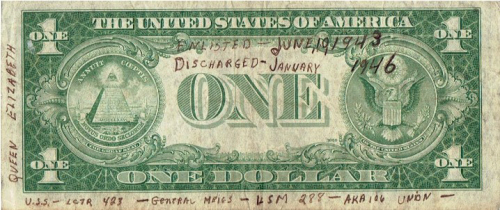 July
27. It
has been very calm weather today, everything is with us, wind, swells and
current. We ought to be in Bizerta by Sat. I hope. If I don’t soon get a haircut
I’ll need a violin. July
27. It
has been very calm weather today, everything is with us, wind, swells and
current. We ought to be in Bizerta by Sat. I hope. If I don’t soon get a haircut
I’ll need a violin.
July
28. We
arrived in Bizerta about 10:00 this morning. It sure is a beat up place, ships
sunk in the harbor and building sunk wrecked by bombs.
July
29.
Greased racks and went to the show at night.
July
30. We
laid around all day long and didn’t do anything. I went to the movie at night.
July
31. We
were still greasing racks. Went up to the red cross for a while this afternoon.
Went to the show at night.
August 1. Pay
Day. I drew $64 today. I am going to send Mom 50 dollars. We got paid in
American Gold seal money. Sure is good to have American money again.
August 3.
Cleaned triggers and went to the show and beer line at the base.
August 4. Got
underway for Italy at 0800 this morning, calm weather.
August 5. Off
Sicily at 1100, 90 degree turn to port at Palermo. Sailing NE. All’s well in
Tyrrhenian Sea.
August 6.
Dropped hook at Naples, Italy at 0900. Weighed anchor and went inside harbor at
1100.
August 7.
Liberty, port side went to Naples for souvenirs.
August 8.
Brought stores aboard and loaded 36 range rockets aboard.
August 9.
Weighed anchor, in large assault convoy LCTS. We left convoy and proceeded on to
load rockets, 481 was hit with a Italian tincan.
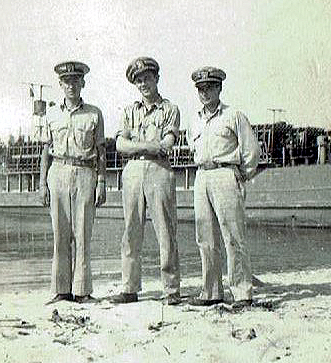 August 10. Alls
well sailing north west. Tied up on Madolelenid(?) Island at 21:00. August 10. Alls
well sailing north west. Tied up on Madolelenid(?) Island at 21:00.
August 11. Took
on full load of rockets and fused them. Took on water and stores in the evening.
[Photo; LCT(R) 423 Officers - Lt Caldwell, Eng TJ Hurley +?]
August 12.
Shoved off to meet invasion convoy at Corsica. 06:00 arrived in Ajaccio, Corsica
at 15:00.
August 13.
Shoved off from Corsica with entire beach head force at 1800. D-day is Tues.
August 14.
Sailing for France. Can hear heavies bombing France.
August 15.
D-Day.
Bombing, naval bombardment of beach. We let the rockets go at 0800. We are
waiting in the transport area now. Someone killed a 439 sailor, buried on
beach.
August 16. We
had an air raid last night. We were tied up together, five of us at night. We
got orders to join convoy. After joining convoy, they told us that we were
needed again so we are heading for beach now.
August 17. We
got back to beach this morning and found out that they didn’t need us, so we are
heading for port Ajaccio at 1300.
August 18. We
got here in Ajaccio this morning at 1130. We brought the ship right up on the
beach. It was a bad storm this afternoon. We will probably be here a couple of
days.
August 22. Went
swimming again today, that’s all I have been doing the past week. I wish I knew
when we would leave this place.
August 30. Well
we are finally leaving. We started for Bizerta at 12:00 this afternoon, expect
to be there Fri. Very calm weather. I hope we turn them (our LCTRs) over (to the
British) in Bizerta.
August 31 to Sept 9. We
are still here in Bizerta. I hope we will turn them over soon.
September 20.
Turned LCTRs over to the British at Messina, Sicily.
October 20. Went
aboard the U.S.S. General Meige for New York.
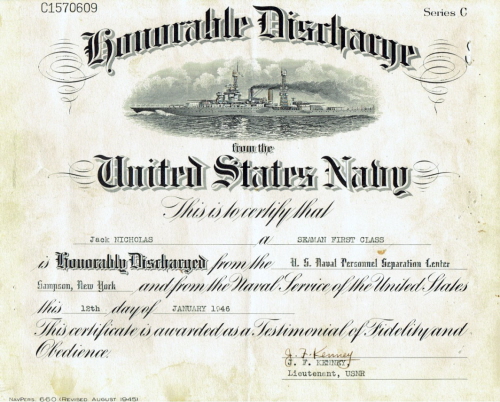 October 23. Stop
again in Oran for more passengers. October 23. Stop
again in Oran for more passengers.
October 30.
Arrived in New York.
Dollar Bill with Locations and Ships
1935
US Silver Certificate Dollar Bill
Enlisted – June 10, 1943.Discharged – January 1946.
Ships:
Queen Elizabeth, USS
LCTR 423, USS
General Meigs & USM
288 (AKA
106 UNION).
Places visited:
Enewetok, Marshall Islands,
Panama,
Pearl Harbor, Guam,
Saipan,
Okinawa,
Trenton(?) China,
Okinwanstou(?) China,
Manila Philippians,
Normandy,
Southern France,
Sicily,
Italy,
England,
North Africa,
Scotland, Isle
of Man and Corsica.
|

_small2.jpg)



 Late in May
Late in May
.jpg) All
craft
All
craft 

 The craft on Blue Beach reported
no opposition. Lieutenant J C Cohen USNR
The craft on Blue Beach reported
no opposition. Lieutenant J C Cohen USNR
%20483%20Crew_small.jpg)
%20483%20II_small.jpg)
 Jack
Nicholas S 2/C,
A.T.B. Camp Bradford N.O.B, Unit
King Tent 67,
Norfolk, VA
Jack
Nicholas S 2/C,
A.T.B. Camp Bradford N.O.B, Unit
King Tent 67,
Norfolk, VA April 29.
Arrived in Dartmouth, England. It is sure pretty good weather here, but liberty
is sure lousy.
April 29.
Arrived in Dartmouth, England. It is sure pretty good weather here, but liberty
is sure lousy. June
1.
Changed rockets around today. We still didn’t go out. Still waiting for the big
push and sick of this shit barge.
June
1.
Changed rockets around today. We still didn’t go out. Still waiting for the big
push and sick of this shit barge. June
16. We
got here in Dartmouth at 02:30. We anchored out until daylight and then we came
in, went ashore and got a haircut, shower and went to the movies.
June
16. We
got here in Dartmouth at 02:30. We anchored out until daylight and then we came
in, went ashore and got a haircut, shower and went to the movies. June
26.
Didn’t go out, took rockets below deck out of the racks. Took fuses away and
then started to scrape. Went on liberty.
June
26.
Didn’t go out, took rockets below deck out of the racks. Took fuses away and
then started to scrape. Went on liberty. July
20. We
ran out of fuel and are being towed by a tug. We went through the Strait of Gibraltar
this afternoon at 1200. Gibraltar was on our left and Spanish Morocco, North
Africa on our right, the water here in the Mediterranean is dark green, where it is sort
of dark blue in the Atlantic. We are still sailing, expect to be there late
tomorrow.
July
20. We
ran out of fuel and are being towed by a tug. We went through the Strait of Gibraltar
this afternoon at 1200. Gibraltar was on our left and Spanish Morocco, North
Africa on our right, the water here in the Mediterranean is dark green, where it is sort
of dark blue in the Atlantic. We are still sailing, expect to be there late
tomorrow. July
27. It
has been very calm weather today, everything is with us, wind, swells and
current. We ought to be in Bizerta by Sat. I hope. If I don’t soon get a haircut
I’ll need a violin.
July
27. It
has been very calm weather today, everything is with us, wind, swells and
current. We ought to be in Bizerta by Sat. I hope. If I don’t soon get a haircut
I’ll need a violin. August 10. Alls
well sailing north west. Tied up on Madolelenid(?) Island at 21:00.
August 10. Alls
well sailing north west. Tied up on Madolelenid(?) Island at 21:00. October 23. Stop
again in Oran for more passengers.
October 23. Stop
again in Oran for more passengers.
